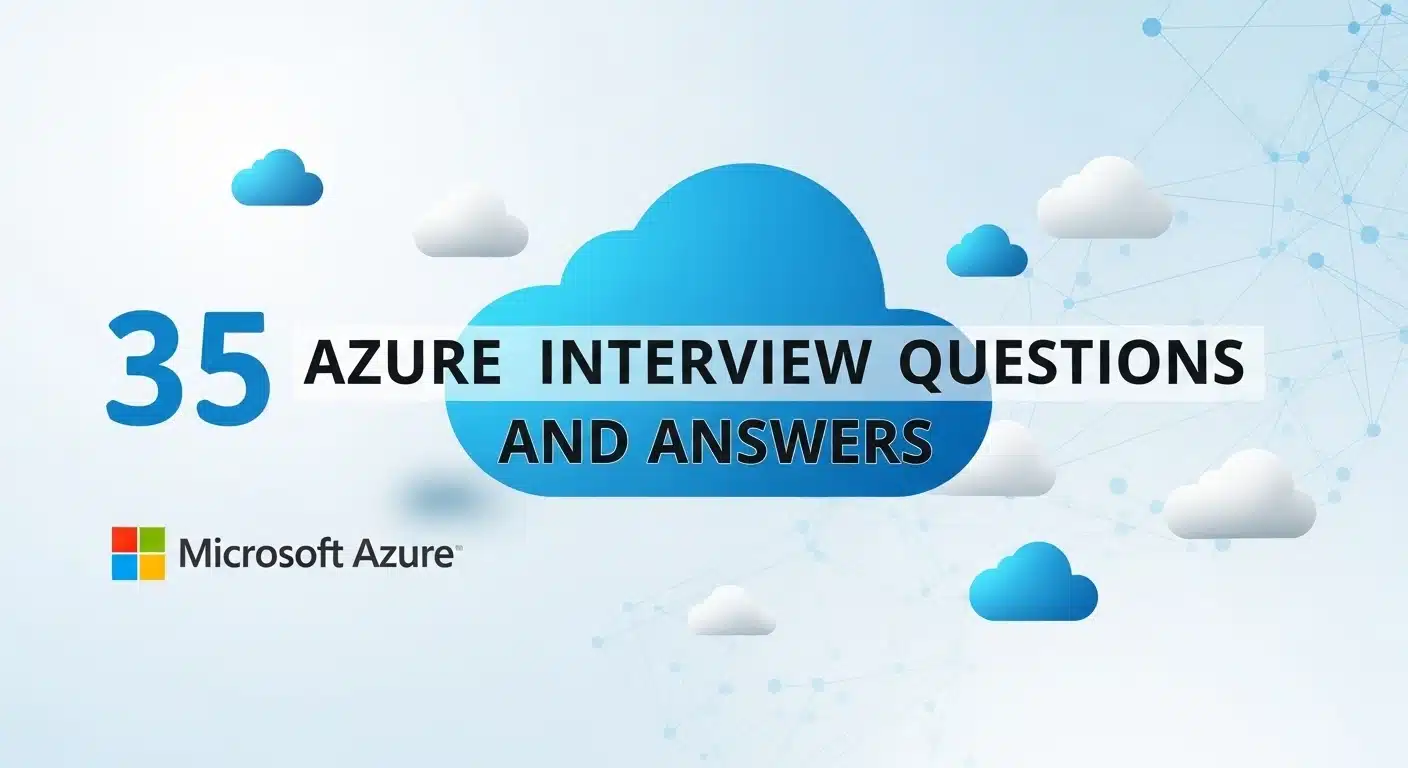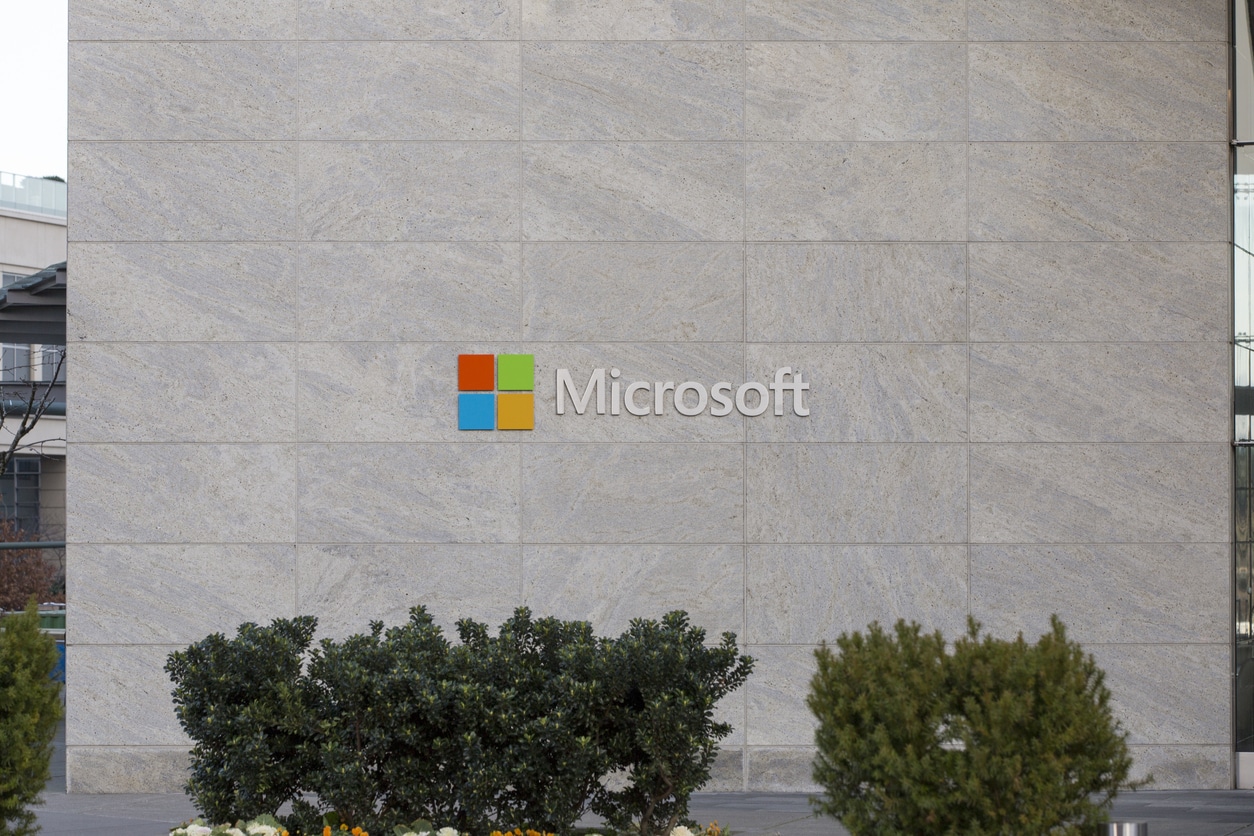Microsoft Azure is a leading cloud platform offering on-demand services like computing, storage, and networking. It exists to provide businesses with flexible, scalable, and cost-effective IT infrastructure.
This guide provides a focused breakdown of common Azure interview questions and answers, covering core concepts, compute, storage, networking, security, and DevOps. Master these to demonstrate your foundational knowledge and land the job.
Build essential Azure skills for cloud engineers, DevOps professionals, and IT administrators. Learn to create virtual networks, deploy virtual machines, and secure cloud storage.
Core Azure Concepts
This is the baseline. If you can't answer these, the rest of the interview is a waste of time.
1. What's the difference between IaaS, PaaS, and SaaS?
This question tests your fundamental cloud knowledge.
IaaS (Infrastructure as a Service): You rent IT infrastructure—servers, virtual machines (VMs), storage, networks—from a cloud provider. You manage the OS, middleware, and applications. Think of it as leasing the hardware. Azure Virtual Machines are a prime example.
PaaS (Platform as a Service): The provider manages the hardware and the operating system. You just manage your applications and data. It’s a platform for you to build on without worrying about the underlying infrastructure. Azure App Service is a classic PaaS offering.
SaaS (Software as a Service): You are just a user of the software. The provider manages everything—the hardware, the OS, the application code. You just use it. Office 365 is a perfect example.
2. Explain the purpose of an Azure Resource Manager (ARM) template.
ARM templates are about Infrastructure as Code (IaC) in Azure. They are JSON files that define the infrastructure and configuration for your project.
What it does: You declare the Azure resources you want, their dependencies, and their configurations in a template.
Why it's important: It makes your deployments consistent, repeatable, and automated. You can deploy an entire complex environment with a single command instead of clicking through the portal for hours. It also allows you to source control your infrastructure.
3. What is the difference between an Availability Set, an Availability Zone, and a Region?
This is about Azure's high availability and disaster recovery story.
Availability Set: This protects your applications from hardware failures within a datacenter. It distributes your VMs across different physical servers, compute racks, and storage units (Fault Domains) and across different software update schedules (Update Domains). If one rack fails or needs an update, your other VMs stay running.
Availability Zone: This protects you from an entire datacenter failure. An Availability Zone is a physically separate datacenter within a single Azure region. Each zone has its own independent power, cooling, and networking. By deploying VMs across multiple zones, you can survive a datacenter-level outage.
Region: A region is a geographic area on the planet containing at least one, but potentially multiple, datacenters that are networked together with a low-latency network. Deploying across regions is for disaster recovery against large-scale events like natural disasters that could take out an entire geographic area.
4. Differentiate between Windows Active Directory and Azure Active Directory (Azure AD).
They share a name, but their functions are different.
Windows Active Directory (AD DS): This is the on-premises directory service. It manages users, computers, and groups on your local network. It handles authentication and authorization for on-prem resources using protocols like Kerberos and LDAP.
Azure Active Directory (Azure AD): This is a cloud-based identity and access management service. It's designed for web-based applications and uses modern protocols like OAuth 2.0, SAML, and OpenID Connect. It manages user access to cloud applications (like Office 365) and Azure resources. It is not a cloud version of Windows AD.
5. What are Azure Policy and Role-Based Access Control (RBAC)? How do they work together?
This is about governance and security.
Azure RBAC (Role-Based Access Control): RBAC is about who can do what. It manages user permissions. You assign users or groups to roles (like "Owner," "Contributor," or "Reader") at a specific scope (like a subscription, resource group, or individual resource). It's for controlling access.
Azure Policy: Azure Policy is about enforcing rules and standards for your resources. It's about what resources can be deployed and how they must be configured. For example, you can have a policy that only allows VMs of a certain size to be deployed, or that all storage accounts must have encryption enabled.
How they work together: RBAC secures who can perform actions. Azure Policy secures what actions can be performed and ensures resources stay compliant. You might have RBAC permission to create a storage account, but Azure Policy might block you if you try to create one without encryption.
Azure Compute Services
This is where your applications run. You need to know the options and their use cases.
6. When would you use Azure Virtual Machines vs. Azure App Service?
This is a classic IaaS vs. PaaS question.
Use Azure Virtual Machines (IaaS) when: You need full control over the operating system and the server environment. This is necessary for "lift-and-shift" migrations of on-prem applications, for applications that require specific OS configurations or software installations, or when you need direct access to the server itself.
Use Azure App Service (PaaS) when: You want to focus only on your application code and not the underlying infrastructure. Azure manages the OS, patching, and scaling. This is ideal for web apps, mobile backends, and REST APIs where you just want to deploy your code and have it run. It's faster to deploy and easier to manage.
7. What is Azure Kubernetes Service (AKS)?
AKS is a managed container orchestration service based on the open-source Kubernetes system.
What it does: It simplifies deploying, scaling, and managing containerized applications. You package your application into containers (like Docker), and AKS handles the rest—scheduling them on a cluster of VMs, managing their lifecycle, and handling service discovery and load balancing.
Why use it: Instead of manually managing Kubernetes, Microsoft manages the control plane (the master nodes) for free. You only pay for the worker nodes (the VMs that run your containers). This reduces the operational overhead of running a complex system like Kubernetes.
8. Explain Azure Functions. What are the main triggers?
Azure Functions is Azure's primary serverless compute offering.
What it is: It allows you to run small pieces of code ("functions") in response to events without having to manage any infrastructure. You are billed only for the time your code runs.
Common Use Cases: Perfect for event-driven tasks like processing file uploads, running scheduled jobs, or building lightweight APIs.
Main Triggers: A trigger is what causes a function to execute. Common triggers include:
- HTTP Trigger: Runs the function when an HTTP request is received.
- Timer Trigger: Runs the function on a schedule.
- Queue Trigger: Runs when a new message is added to an Azure Storage Queue.
- Blob Trigger: Runs when a new or updated blob is detected in Azure Blob Storage.
9. What are Virtual Machine Scale Sets (VMSS)?
VMSS lets you create and manage a group of identical, load-balanced VMs.
Key Feature: The number of VM instances can automatically increase or decrease in response to demand or a defined schedule (autoscaling).
Why use it: It's designed for building large-scale services that need high availability and elasticity. It ensures that your application can handle traffic spikes by automatically adding more VMs and can save money by removing them when they aren't needed.
10. Differentiate between a system-assigned and a user-assigned Managed Identity.
Managed Identities provide an identity for applications to use when connecting to resources that support Azure AD authentication, without needing to manage credentials.
System-assigned Managed Identity:
- Tied directly to an Azure resource (e.g., a specific VM or App Service).
- Its lifecycle is tied to that resource. If you delete the resource, the identity is also deleted.
- Simple to set up for a single resource.
User-assigned Managed Identity:
- Created as a standalone Azure resource.
- Can be assigned to one or more Azure resources.
- Its lifecycle is independent of any resource it's assigned to.
- Useful when you want to assign the same set of permissions to multiple resources or pre-authorize an identity before resources are created.
Azure Storage
11. What are the four main types of Azure Storage services?
Azure offers several types of storage, each for a different purpose.
- Blob Storage: Object storage for massive amounts of unstructured data, like text or binary data. Used for images, videos, backups, and big data analytics.
- File Storage: Managed file shares for cloud or on-premises deployments. Accessible via the standard Server Message Block (SMB) protocol, making it great for "lift-and-shift" applications.
- Queue Storage: A messaging store for reliable messaging between application components.
- Table Storage: A NoSQL store for schemaless storage of structured data. It's a key-attribute store, good for large-scale, flexible data storage.
12. Explain the difference between Azure Blob Storage and Azure Disk Storage.
This question checks if you understand the primary use cases for two common storage types.
Blob Storage: Is an object store. You use it to store files, documents, images, videos, and backups. It is accessed over HTTP/S.
Disk Storage: Provides persistent block storage for Azure Virtual Machines. These are the virtual hard drives attached to your VMs that store the operating system, applications, and data. You can choose between Standard HDD, Standard SSD, Premium SSD, and Ultra Disk based on performance needs.
13. What are the different access tiers for Blob Storage?
Blob storage tiers allow you to store data more cost-effectively based on how frequently it will be accessed.
- Hot Tier: Optimized for storing data that is accessed frequently. Highest storage costs, lowest access costs.
- Cool Tier: Optimized for storing data that is infrequently accessed and stored for at least 30 days. Lower storage costs and higher access costs compared to Hot.
- Archive Tier: Optimized for storing data that is rarely accessed and stored for at least 180 days with flexible latency requirements (on the order of hours). Lowest storage cost but highest data retrieval costs.
14. What is Azure Data Lake Storage (ADLS)?
ADLS is a scalable and secure data lake for big data analytics workloads.
What it is: It's built on top of Azure Blob Storage but adds features specifically for big data, like a hierarchical file system and more granular security controls (ACLs).
Why use it: It's designed to store and analyze petabyte-size files and trillions of objects. It's the foundation for building modern data warehouses and machine learning solutions in Azure.
15. How do you secure an Azure Storage Account?
There are multiple layers of security for storage accounts.
- Access Keys: These are essentially root passwords for your storage account. They should be used sparingly and rotated regularly.
- Shared Access Signatures (SAS): Provide delegated access to resources in your storage account with specific permissions, over a specified time interval, without sharing your account keys.
- Role-Based Access Control (RBAC): Use Azure AD to grant granular permissions to users, groups, and applications to access blob and queue data.
- Network Security: Use firewall rules and virtual network service endpoints to restrict access to your storage account from specific public IP addresses or Azure VNets. Use Private Endpoints to give services in your VNet secure access to storage via a private IP address.
- Encryption: Data is encrypted at rest by default (Storage Service Encryption) and in transit (using HTTPS).
Azure Networking
Resources are useless if they can't communicate securely and efficiently. So networking is Important.
16. What is an Azure Virtual Network (VNet)?
A VNet is the fundamental building block for your private network in Azure. It enables Azure resources like VMs to securely communicate with each other, the internet, and your on-premises networks. A VNet is isolated to a single region and is segmented into one or more subnets.
17. Explain the difference between Azure Load Balancer and Application Gateway.
Both distribute traffic, but they operate at different layers of the OSI model.
Azure Load Balancer: Operates at Layer 4 (Transport layer - TCP, UDP). It distributes traffic based on source IP address, source port, destination IP address, destination port, and protocol. It doesn't know anything about the content of the traffic.
Azure Application Gateway: Operates at Layer 7 (Application layer - HTTP, HTTPS). It's a web traffic load balancer that can make routing decisions based on the attributes of an HTTP request, such as the URL path or host headers. It also provides features like SSL termination and a Web Application Firewall (WAF).
18. What is a Network Security Group (NSG)?
An NSG contains a list of security rules that allow or deny network traffic to resources connected to Azure VNets.
How it works: You can associate an NSG with a subnet or a network interface (NIC). Rules are processed in priority order to determine whether traffic is allowed or denied based on source/destination IP, source/destination port, and protocol. It acts as a basic stateful firewall.
19. How does VNet Peering work?
VNet peering connects two Azure virtual networks, allowing them to communicate with each other as if they were one network.
Key points: The traffic between the peered VNets uses the Microsoft backbone network, so it's private and doesn't traverse the public internet. It provides a low-latency, high-bandwidth connection. You can peer VNets in the same region (VNet Peering) or in different regions (Global VNet Peering).
20. How can you connect an on-premises network to an Azure VNet?
This is a core hybrid cloud question. There are three main ways:
- Site-to-Site VPN: Creates an encrypted tunnel over the public internet between your on-premises VPN device and an Azure VPN Gateway. It's a secure and common way to extend your on-prem network.
- Point-to-Site VPN: Connects an individual client computer to your Azure VNet over the internet. Useful for remote employees who need to connect to Azure resources.
- ExpressRoute: Establishes a private, dedicated, high-throughput connection between your on-premises network and Azure through a connectivity provider. It doesn't go over the public internet, offering higher reliability, faster speeds, and lower latencies than a typical internet connection.
21. What is the difference between Azure Firewall and an NSG?
While both control traffic, their capabilities are very different.
NSG: A simple packet filter that works at Layer 4. It allows/denies traffic based on IP, port, and protocol. It's applied to NICs or subnets.
Azure Firewall: A fully stateful, managed firewall-as-a-service. It works at both Layer 4 and Layer 7. It provides more advanced features like application-level filtering (e.g., allow access to *.github.com), built-in threat intelligence, and centralized logging and policy management for all your VNets.
Azure Security and Identity
Security is non-negotiable. You must know these concepts.
22. What is Microsoft Defender for Cloud (formerly Azure Security Center)?
Defender for Cloud is a unified infrastructure security management system.
What it does: It provides security posture management and threat protection for your workloads running in Azure, on-premises, and in other clouds.
Key Features:
- Secure Score: Provides recommendations to improve your security posture.
- Threat Detection: Uses advanced analytics and threat intelligence to detect and alert on threats across your resources.
- Compliance Management: Helps you assess and maintain compliance with standards like ISO 27001 and PCI DSS.
23. Explain how Azure Key Vault works.
Azure Key Vault is a cloud service for securely storing and accessing secrets.
What it stores:
- Secrets: Small pieces of sensitive data like API keys, database connection strings, or passwords.
- Keys: Cryptographic keys used for encryption.
- Certificates: SSL/TLS certificates.
Why use it: It centralizes the storage of your application secrets, reducing the chance they are accidentally leaked in your code or configuration files. Access to the vault is tightly controlled through Azure AD identities and access policies.
24. What is Azure AD Conditional Access?
Conditional Access is the tool used by Azure AD to bring signals together, to make decisions, and to enforce organizational policies.
How it works: It's an "if-then" statement. If a user wants to access a resource, then they must complete an action.
- Signals (If): User location, device health, sign-in risk level.
- Decisions/Actions (Then): Block access, grant access, or require multi-factor authentication (MFA). For example, you can create a policy that requires MFA for all administrators, or blocks access from unmanaged devices.
25. What is a Service Principal in Azure?
A Service Principal is an identity created for use with applications, hosted services, and automated tools to access Azure resources.
Think of it as: A "user identity" for an application. Instead of an application logging in with a user's credentials, it uses its own service principal.
How it works: You create a service principal in Azure AD and then use RBAC to assign it only the specific permissions it needs to do its job, following the principle of least privilege. Authentication is typically done with a client secret or a certificate.
26. Explain the Shared Responsibility Model in the cloud.
This model defines which security tasks are handled by the cloud provider (Microsoft) and which are handled by you (the customer).
- Microsoft's Responsibility: Securing the cloud itself. This includes the physical security of the datacenters, the network infrastructure, and the host hypervisors.
- Your Responsibility: Securing what's in the cloud. This always includes your data, your identities, and access management. Depending on the service model (IaaS, PaaS, SaaS), your responsibility changes. For IaaS, you are also responsible for patching the OS, network controls, and the application.
Post Graduate Program in Cloud Computing by UT Austin
Master AWS, Azure & GCP in 6 months with 200+ projects & GenAI tools. Get career-ready with UT Austin’s Cloud Computing Certificate
Azure DevOps & Management
Deployment and management are critical for any serious application.
27. What is Azure DevOps?
Azure DevOps is a suite of services that helps teams plan, build, test, and deploy applications.
Core Components:
- Azure Boards: Agile planning, work item tracking, and reporting.
- Azure Repos: Provides Git repositories for source control.
- Azure Pipelines: A CI/CD (Continuous Integration/Continuous Deployment) service to automatically build and test code and release it to any target.
- Azure Test Plans: Tools for manual and exploratory testing.
- Azure Artifacts: A package management service for hosting and sharing packages like Maven, npm, and NuGet.
Also Read: DevOps Interview Questions and Answers
28. What is Azure Monitor?
Azure Monitor is the native platform service for collecting, analyzing, and acting on telemetry from your cloud and on-premises environments.
What it does: It collects metrics and logs from virtually all Azure resources. You can then visualize this data with dashboards, analyze it with Log Analytics, and set up alerts to be notified of performance issues or failures. It's the central tool for observability in Azure.
29. How would you implement a cost management strategy in Azure?
This is a critical operational question.
- Azure Cost Management + Billing: Use the portal to analyze costs, create budgets, and get recommendations.
- Tagging: Implement a consistent tagging strategy for all resources. This allows you to group costs by project, department, or environment.
- Azure Policy: Enforce tagging rules and restrict the deployment of expensive resource types.
- Azure Advisor: Use Advisor to get recommendations for optimizing costs, such as identifying idle resources or right-sizing VMs.
- Budgets and Alerts: Set up spending budgets for subscriptions or resource groups and configure alerts to notify you when costs are approaching a threshold.
Scenario-Based Questions
These questions test your ability to apply knowledge to solve a problem.
30. A company wants to migrate a three-tier on-premises application to Azure. The application consists of a web front-end, a business logic tier, and a SQL Server database. How would you approach this migration?
There's no single right answer, but a good response shows you can think through the options.
Phase 1: Assessment. First, use a tool like Azure Migrate to assess the on-prem servers. Understand the dependencies, performance requirements, and current configuration.
Phase 2: "Lift and Shift" (IaaS). The most straightforward initial approach is to move the application with minimal changes.
- Web/Business Tiers: Replicate the on-prem VMs to Azure VMs. Place them in an Availability Set or across Availability Zones for high availability. Put them behind an Azure Load Balancer.
- Database: Migrate the on-prem SQL Server to a SQL Server instance running on an Azure VM. This gives you the most compatibility but requires you to manage the VM and SQL Server instance.
Phase 3: Optimization (PaaS). After the application is stable in Azure, look for opportunities to modernize and reduce management overhead.
- Web/Business Tiers: Refactor the application to run on Azure App Service. This eliminates the need to manage the underlying VMs.
- Database: Migrate the SQL Server VM to a PaaS offering like Azure SQL Database or Azure SQL Managed Instance. This offloads database management tasks like patching, backups, and high availability to Azure.
31. Your web application is experiencing slow performance for users in a different geographic region. How would you address this?
This is about global scale and performance.
- Azure Front Door / Traffic Manager: These are global load-balancing services.
- Azure Traffic Manager: A DNS-based traffic load balancer that can direct users to the closest regional endpoint based on various routing methods.
- Azure Front Door: A more advanced service that operates at Layer 7. It provides global HTTP load balancing, SSL offloading, and a Web Application Firewall (WAF) at the edge. It can route traffic to the fastest and most available backend.
- Content Delivery Network (CDN): For static content (images, CSS, JavaScript), use Azure CDN to cache content in edge locations closer to users. This drastically reduces latency for static assets.
- Regional Deployment: Deploy instances of your application in multiple Azure regions closer to your users. Use Front Door or Traffic Manager to route users to the nearest deployment.
32. You need to process a large number of images uploaded by users. The processing involves resizing the image and applying a watermark. The process must be scalable and cost-effective. What Azure services would you use?
This is a classic serverless architecture problem.
- Storage: Use Azure Blob Storage to store the uploaded images. Create two containers: one for raw uploads and one for processed images.
- Compute: Use an Azure Function with a Blob Trigger. The function will automatically execute whenever a new image is uploaded to the "raw uploads" container.
- Processing Logic: The function code will contain the logic to download the blob, resize it, apply the watermark, and then save the new image to the "processed images" container.
Why this works: This architecture is highly scalable. Azure Functions and Blob Storage will scale automatically to handle any number of uploads. It's also cost-effective because you only pay for the storage used and the milliseconds of function execution time. You are not paying for idle VMs.
33. A team needs to ensure that no Virtual Machines can be deployed with a public IP address directly attached to the NIC. How would you enforce this rule across the entire subscription?
This is a governance and security question. The best tool for this is Azure Policy.
The Solution: You would create a custom Azure Policy definition that audits or denies the creation of a Network Interface (NIC) resource if it has a public IP address associated with it.
Implementation:
- Define the policy rule logic to check the Microsoft.Network/networkInterfaces resource type for the presence of a publicIPAddress property.
- Create a policy definition with this rule and set the effect to Deny.
- Assign this policy to the subscription scope.
Result: After the policy is applied, any attempt to create a VM with a public IP on its NIC will be blocked by the Azure Resource Manager, ensuring compliance with the security requirement.
34. How would you design a highly available solution in Azure that can withstand a regional outage?
This requires a multi-region architecture.
- Primary/Secondary Regions: Choose two Azure regions (a primary and a secondary).
- Global Load Balancing: Use Azure Front Door or Azure Traffic Manager as the global entry point for your application. Configure it to send traffic primarily to the active region.
- Data Replication: The critical component is data.
- For databases like Azure SQL or Cosmos DB, configure geo-replication to maintain a readable secondary in the backup region.
- For Azure Storage, use Geo-Redundant Storage (GRS) or Geo-Zone-Redundant Storage (GZRS) to replicate your data to the secondary region.
- Infrastructure Deployment: Use ARM templates or Terraform to ensure you can deploy your infrastructure consistently in both regions.
- Failover Process: The load balancer (Front Door or Traffic Manager) will detect if the primary region is unavailable and automatically route all traffic to the secondary region. You will need a process to perform a failover for your database to make the secondary replica writable.
35. You are designing a solution that requires a secure, private connection to an Azure SQL Database from a Virtual Network, ensuring that no traffic goes over the public internet. How would you achieve this?
The answer here is Azure Private Endpoint.
What it is: A Private Endpoint is a network interface that uses a private IP address from your VNet. This interface connects you privately and securely to a service powered by Azure Private Link, like Azure SQL Database or Azure Storage.
How it works:
- You create a Private Endpoint for your Azure SQL Database within one of your VNet's subnets.
- This gives the SQL database a private IP address on your VNet.
- You then configure your applications within the VNet to connect to the SQL database using this private IP address.
Result: All traffic to the database from your VNet now flows over the Microsoft backbone network, completely isolated from the public internet. You can even disable the public endpoint of the SQL database for maximum security.
Also Read:






